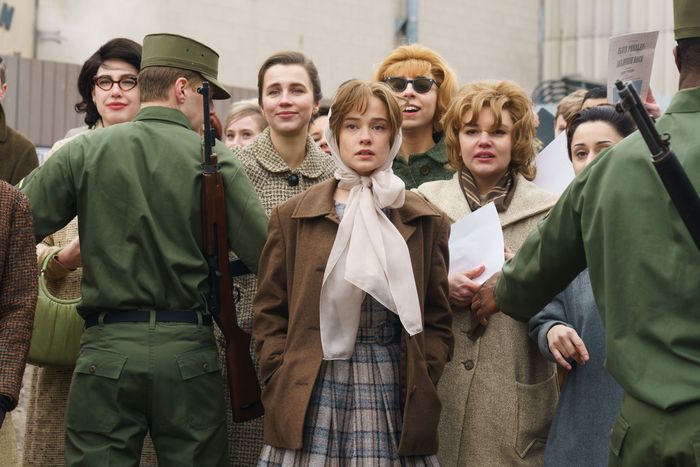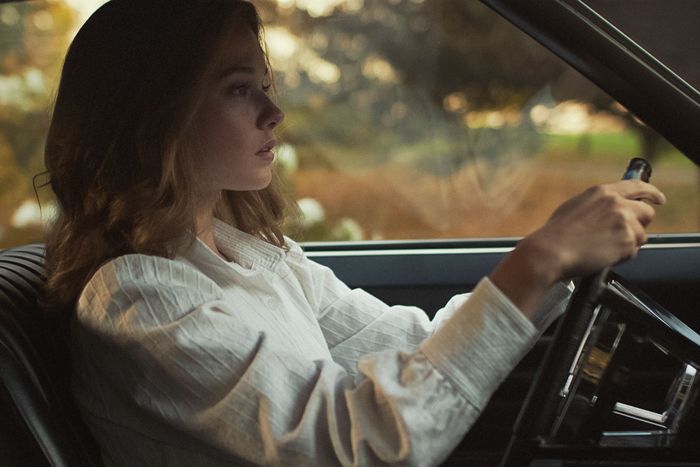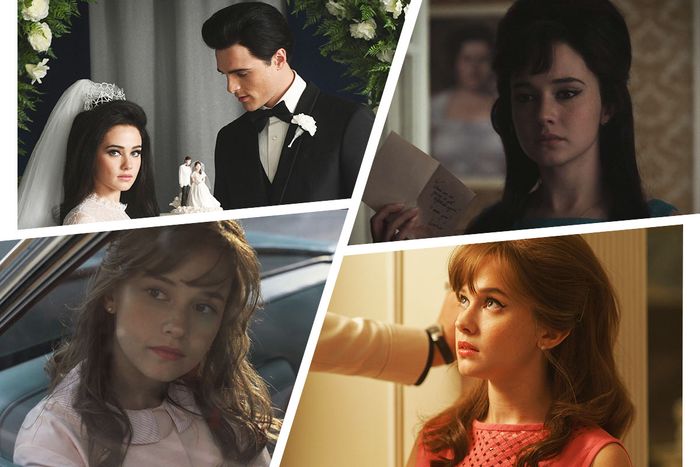
This article was originally published on November 9. We are recirculating it now timed to Priscilla’s digital release. Be sure to also read Alison Willmore’s review of the film, and our interview with Phoenix frontman Thomas Mars on scoring Sofia Coppola’s films.
Sofia Coppola’s Priscilla is a love story, but it’s also about concentric circles of control: about the overwhelming control megastar Elvis Presley (Jacob Elordi) has over his confidant-then-girlfriend-then-wife Priscilla Beaulieu (Cailee Spaeny), and the limited control Priscilla has over her own life. Even Priscilla’s clothes must follow strict guidelines laid out by Elvis — no browns (they remind him of the Army), no prints, no oversize items. But her clothing also eventually reflects Priscilla’s growing confidence in herself. How Coppola’s protagonists dress has always been thematically illuminating: Think of the Lisbon sisters’ matching floral-print homecoming outfits in The Virgin Suicides, Elle Fanning’s satin ballgown as she tries to seduce Colin Farrell’s Union soldier in The Beguiled, and Marie Antoinette’s pink Chuck Taylors. In Priscilla, though, the costuming is even more integral than usual — with so few opportunities for Spaeny’s young bride and mother to hold her own against the at-first adoring, later domineering Elvis, her outward presentation says what she is unable to.
Priscilla is an adaptation of Priscilla Presley’s 1985 memoir Elvis and Me, and is also costume designer Stacey Battat’s sixth collaboration with Coppola after On the Rocks, The Beguiled, A Very Murray Christmas, The Bling Ring, and Somewhere. The film follows 13 years of Priscilla’s life, from her first meeting with Elvis in 1959 to the day she left him in 1972, a period that required 120 costumes for Priscilla and 90 costumes for Elvis, all with only 30 days to film. Battat’s six weeks of prep were devoted to studying Coppola’s script, perusing ’50s, ’60s, and ’70s editions of magazines like Vogue and Harper’s Bazaar, visiting the Metropolitan Museum of Art’s Antonio Ratti Textile Center and Reference Library, working with hair department head Cliona Furey and makeup department head Jo-Ann MacNeil, and creating 90 percent of the costumes seen in the film. “We were constantly making clothes, like, all the time,” Battat says with a laugh.
Coppola provided moodboards to Battat and other department heads, laying out certain elements of the film, like its color palette. Priscilla starts with “dusty browns and grayed-down colors” in West Germany before moving into brighter pale blues, yellows, and corals in Graceland. “Sofia had always said she thought the sun came out in Memphis, so then the clothes were brighter,” Battat explains. When Priscilla comes into her own and decides to divorce Elvis, the film is defined by “stronger colors” that are more saturated and concentrated, like royal blues and emerald greens. The feeling Battat took from the moodboards and then reflected in Priscilla’s costuming evolution, she says, was a sense of “discovery … somebody enamored by a world and then kind of unwrapping it slowly and seeing a different inside.”
“An innocence, but also a naïveté”
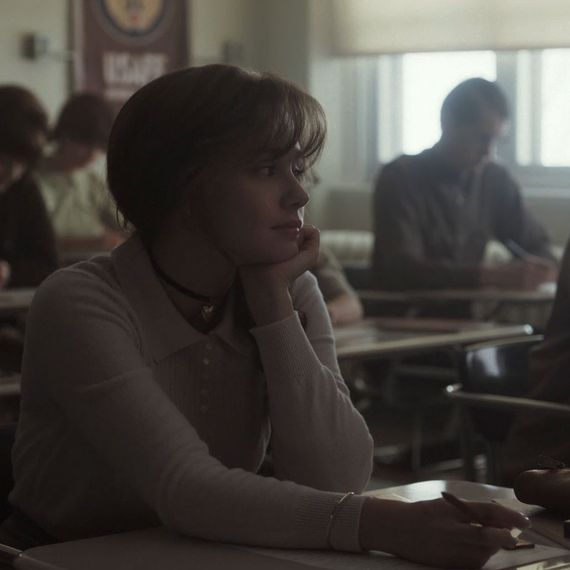
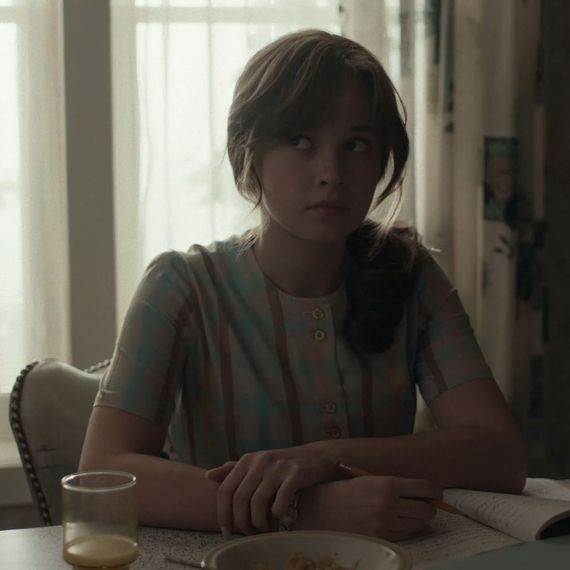
When the film begins in 1959, Priscilla is a 14-year-old high-school freshman living in West Germany with her mother and stepfather; understandably, they’re surprised when she’s invited to a party at Elvis’s house and even more surprised when the 24-year-old superstar expresses interest in seeing her again. Priscilla, though, is more concerned about what to wear whenever she sees Elvis, and often settles on dresses with the poofier, fit-and-flare silhouettes that were popular at the time, Battat explains.
In reality, those dresses were often two-pieces so that the production could mix and match to create other outfits. Both at school and on dates with Elvis, Priscilla wears an array of cardigans, crafted by designer Colin McNair with the knitwear company Eòlas. (Battat had a hard time finding vintage cardigans that “felt of that era. They didn’t have the right details, it was bumming me out.”) The outfits’ other accents and details — including stripes, oversize buttons, and all kinds of bows — emphasized Priscilla’s youthfulness. The danger, though, was making Priscilla seem too youthful.
In Elvis and Me, the real Priscilla writes that she wore a sailor dress when she met Elvis for the first time, and “I feel like Sofia had written this in the script, too,” Battat says. “The misconception of their relationship is, she was 14 and he was so much older, and that is true. But I also think their relationship was not creepy. They were confidants, they both had a similar homesick thing. And when we put her in the sailor dress, the visual was a little creepy. She just seemed too young.” So instead, Priscilla wears a knee-length, baby-blue dress paired with a gold heart-locket necklace similar to one Priscilla actually wore in her youth, and that assistant costume designer Gillian Steinhardt designed and then had fabricated in Canada. The team also recreated Priscilla’s good-bye look when Elvis leaves West Germany in 1960, which included a gauzy headscarf, brown jacket, and blue-and-brown plaid dress, the skirt of which Battat reused for a scene where Priscilla is in school.
“I think it was 50/50,” Battat says of the split between real-life outfits of Priscilla’s the costumers mimicked and others that they created and based on trends of the time. In the former category was also Priscilla’s wedding dress, which in 1967 she bought off the rack but in the film is recreated by Chanel, with lace Battat selected from Virginie Viard’s archives. (“Everybody gasped at the sight of the dress,” Battat says.) In the latter category were specifics “not out of the realm of possibility” for Priscilla to have worn, like a lattice-work top that Battat designed for the film, and the turtlenecks, sweaters, and pants Elvis wears at home. Many of those pieces were made by Valentino and inspired by a moodboard Battat created specifically for Elvis.
The most important aspect of the clothes in Priscilla’s schoolgirl phase was establishing “an innocence, but also a naïveté,” Battat says. All the clothes had to maintain that “wide-eyed” sense, which is why a few were cut entirely. “There was a green top and skirt that I love, but we never used it. I felt like it looked too sophisticated in the end,” Battat says.
“We wanted it to feel both right and wrong”
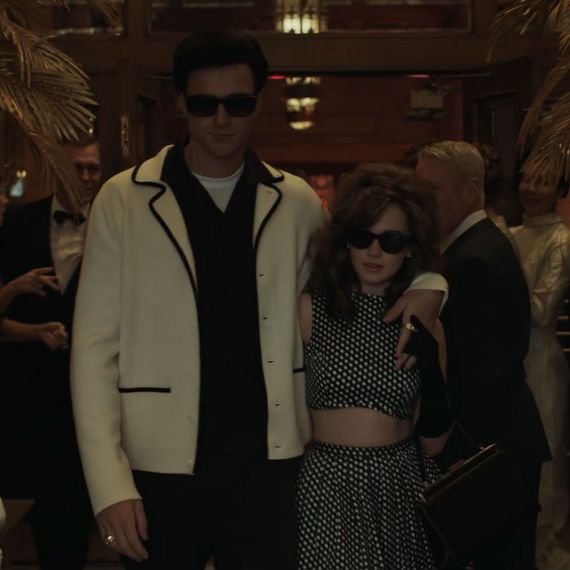
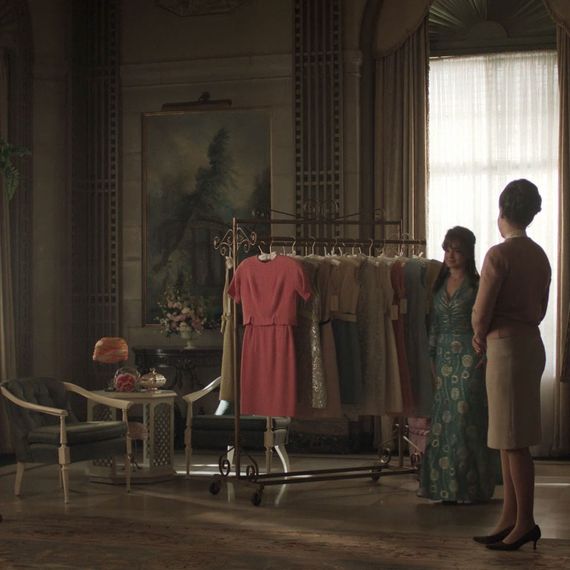
The bulk of Priscilla takes place in Graceland, which the titular character first visited in 1962. While Priscilla packs for her two-week trip, Coppola’s camera lingers over the pink-satin-lined suitcase and the clothes inside, including a frilly white nightgown with a neck bow and a matching set of bloomers that Battat fashioned from deadstock fabric — and that Priscilla sleeps in for two days after taking a pill Elvis offers her. To make up for their lost time, Elvis takes Priscilla to Las Vegas for a sequence that was originally supposed to be longer, Battat says.
“There was originally in the script a scene where Elvis took her shopping in Vegas to get her appropriate clothes for Vegas, but it got cut for whatever reason; budgetary more likely than anything else,” Battat says. “But it was always in our minds that Elvis did take her shopping, and when she leaves Vegas, she wears this polka-dot two-piece outfit that bares her midriff. I had seen a photo like that in Vogue or something from that time. That was a great moment kind of like, She’s almost a woman, but she’s still in her girlish silhouette.”
After Priscilla’s parents allow her to move into Graceland in 1963, with Elvis’s father, Vernon, acting as her guardian until she finishes high school, her costumes continue to walk that line. At that transitional point in Priscilla’s life, and during a shopping trip presented as a treat for her, Elvis explicitly dictates how he expects her to look. His “blue’s your color” advice means that Priscilla dresses almost exclusively in shades of baby and dusty blue, azure, sky, teal, and sapphire for years to come, and his mandate that she dye her hair black (like his) and wear black eye makeup sets her onto a path of ever-higher bouffants and ever-more-angled eyeliner. During that scene, it’s Priscilla alone against Elvis and his crew of male hangers-on, who pass judgment on how she looks in an array of full-length gowns of lace and satin that she worries are “too sophisticated for me.” The blue dresses come home with her, though, because Elvis prefers them, and like many of the film’s costumes, are worn by Priscilla more than once.
“There was a photo in a magazine and I saw a dress similar to that,” Battat says of the cobalt gown from the sequence when Elvis declares blue as Priscilla’s fated hue. “We managed to find that exact dress at a costume house, which was insane. It was a very pale pink and the color faded too much into Cailee’s skin, and we wanted to recreate something similar. We searched hard to find the beading and the boning. She wore it in a limo scene and she wore it somewhere else,” along with a shawl made by cutter Ahmad Zargaran.
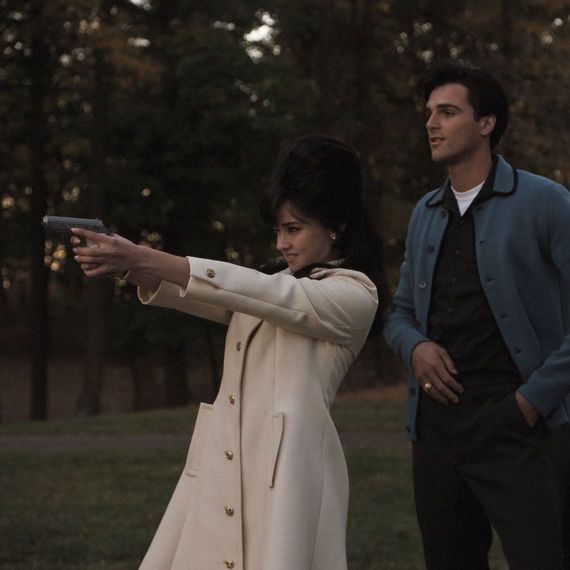
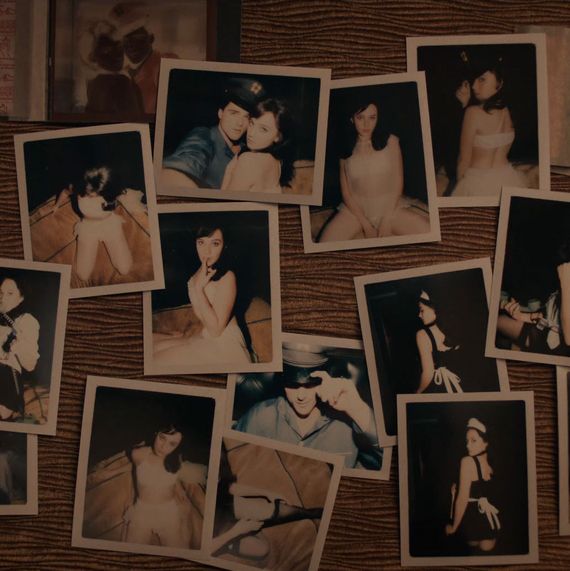
Clothes remain at the center of Elvis and Priscilla’s flirtations and fights over the years, both while she’s his secret girlfriend and after their marriage. When Elvis gifts her numerous guns so they can shoot together, Priscilla matches their specially colored grips with her outfits; the first time she actually yells and curses at him, it’s after he tells her that a short patterned red dress “doesn’t suit you.” “It’s not in our color palette for that time,” Battat says, and yet “we wanted the dress to look good on her. We wanted it to feel both right and wrong.”
There’s a similar duality to a montage of Elvis and Priscilla taking photographs in bed together, with her cycling through an array of saucy lingerie: a black lace two-piece with garters and thigh-highs, a French maid’s uniform, a secretary-styled outfit. Battat worked with Spaeny and her stand-in Laura Thorne to figure out where the costumes would be stored in the couple’s bedroom, and how to keep the costume-changes looking natural on camera. In the scene, Priscilla and Elvis laugh and tease each other in the bedroom where they spend so much time talking, watching TV, and eating their meals, until Elvis hits Priscilla too hard during a pillow fight and ruins the moment. “There was a lingerie timeline, a full lingerie inspiration board. They’re in bed so much,” Battat says of the pair. “He always had his pajamas with the E. P. [initials], but she turned into a woman in the bedroom and in the lingerie.” There’s “excitement” in this phase of Priscilla’s life, Battat says, but the young woman’s isolation from the outside world and her practical entrapment in Graceland — especially once she becomes pregnant with daughter Lisa Marie soon after her and Elvis’s marriage — gives the film an increasingly claustrophobic feel.
Good-bye to Graceland
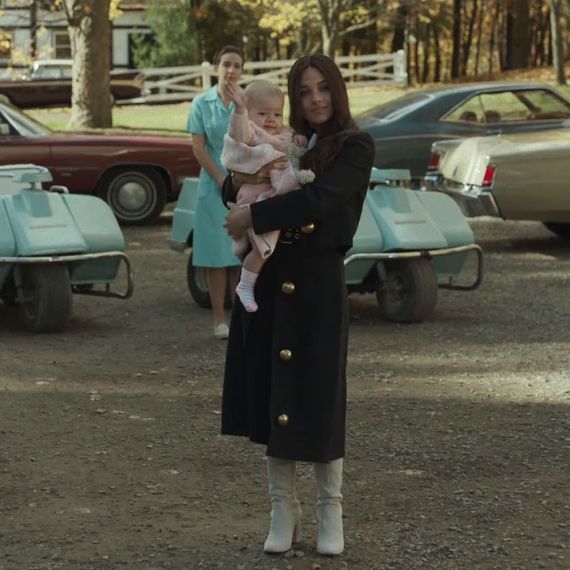
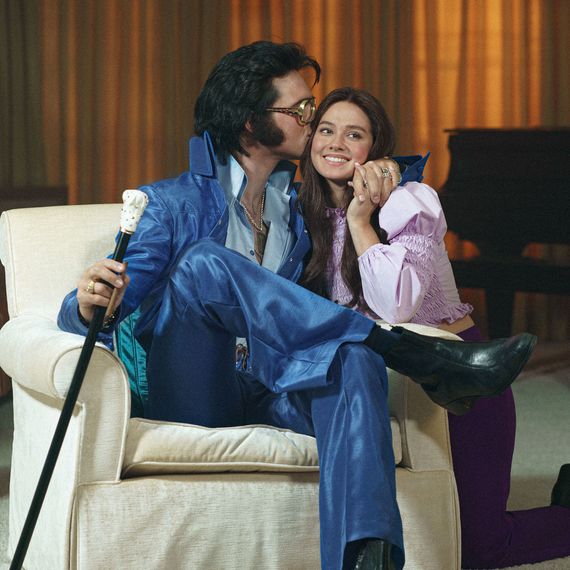
In the film’s final — and shortest — act, Priscilla jumps forward to 1970 and then continues hopping forward in time. At first, much of Elvis and Priscilla’s relationship is the same: He doesn’t let her and toddler Lisa Marie come on tour, leaving them in Graceland while he and the boys return to their road high jinks (with Elvis often cheating on Priscilla while telling her she needs to “lighten up”). But Priscilla’s growing resolve to break away from Elvis’s desires come through in her costuming (outfits in black, purple, and patterns) and her lighter-colored hair and naturalistic makeup.
Their growing distance from each other is obvious in the family-portrait scene where Elvis is dressed up in a blue leather jumpsuit with gilded glasses and a marble-topped cane and Priscilla is dressed down in a lavender blouse and amethyst bottoms, the first time in the film she wears pants while Elvis is around. (Battat snuck pants on Spaeny for another scene, but they were for warmth, not impact: “It was super cold out, and I was like, I gotta give this poor girl a pair of pants. I can’t send her outside to shoot guns with Elvis” in a skirt, she says.) For the photographer, Priscilla smiles and poses, but as soon as he says, “I think we got it,” Priscilla leaves Elvis’s side — not lingering a moment longer than she has to — and goes to tend to Lisa Marie.
The image, without the behind-the-scenes baggage, is an iconic one, and the costume department wanted to recreate it as accurately as possible, Battat says. Elvis’s jumpsuit, for which Elordi “did a bunch of fittings,” was based off Presley’s original patterns and created by costume company B&K Enterprises. Spaeny’s outfit was made in house, with a “zipper up the back so that it could accommodate coming on and off quickly” without disturbing her Cher-like hair.
That purple pair of pants is a harbinger of change to come for Priscilla, who starts to spend time in Los Angeles pursuing her own hobbies and interests and raising Lisa Marie, and then in 1972 tells Elvis she’s leaving him. She’s wearing a collared shirt and blazer in that scene, a professional look that’s similar to the final blouse and pants she dons while hugging Graceland’s female staff members good-bye. “Sofia did say to me, ‘At the end, she’s wearing pants, she says good-bye in pants.’ It was always decided,” Battat says. The choice was based on both “the silhouettes of the time, and how far Elvis and Priscilla moved away from one another,” she adds.
In the final cut, Priscilla’s good-bye is set to Dolly Parton’s “I Will Always Love You,” which plays as Priscilla leaves the mansion, gets in her car, and drives herself out of Graceland’s distinctive gates, decorated with music notes and silhouettes of Elvis. Parton’s country classic fits the plaintive-yet-hopeful energy of the scene, which suggests that Priscilla’s future is waiting for her to claim it. But on set, Coppola cued up Mazzy Star’s “Fade Into You,” a more recent generation-spanning favorite that — in a moment both poignant and cathartic for the cast and crew — had people in tears, according to Battat.
“It was just so emotional. Cailee was acting, but probably not; she was probably just crying,” Battat says. “I was crying, too. I was like, ‘I know what happens, I’ve read the script 100 times. I just finished making that costume, like, eight minutes ago. That’s probably why I’m crying.”
More on Priscilla
- Jacob Elordi Is Sorry If You Watched Saltburn With Your Parents in SNL Monologue
- The Science of Scoring Sofia Coppola’s Movies
- In Priscilla, She’s the Girl Who Has Everything — Except Actual Power



